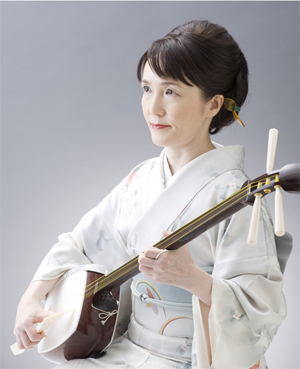
|
|
Arts at Tenri presents
Nami Kineie, Nagauta Shamisen

Saturday, October 10, 2009, 8:00pm
NAMI KINEIE – NAGAUTA SHAMISEN
with Shizuko Kineya and Sakurako Satoh, shamisenand Sachiyo Ito, Dancer,
James Nyoraku Schlefer, Shakuhachi
Nami Kineie is well known to Japanese audiences for her frequent performances
of both the traditional Nagauta style of shamisen, and her dedication
to performing contemporary music. The program for October 10 will include
several classic Kabuki Theater pieces (Suehirogari, Sagimusume) plus contemporary
music by Seiho Kinea, James Nyoraku Schlefer and Etsuo Kawasaki.
Accompanying Ms. Kineie on several pieces will be her top student Sakurako
Satoh and she is delighted to be joined on one piece by the venerable
shamisen master Kineya Shozuko. Additionally two well known New York based
artists will perform with her – dancer Sachiyo Ito and shakuhachi
master James Nyoraku Schlefer.
A native of Tokyo, Ms. Kineie is a member of the renowned Pro Ensemble
Nipponia. She is a graduate of the Tokyo University of Fine Arts (1980),
is on faculty at Bunkyo University, and heads her own school of Shamisen.
The shamisen is the traditional three-string lute of Japan and is heard
in many styles of music including Kabuki, Bunraku puppet theater, classic
Jiuta and the folk style known as Tsugaru. The body is made out of wood
and covered with cat or dog. The three strings are traditionally made
of silk. The lowest passes over a small hump at the "nut" end
so that it buzzes, creating a characteristic sound known as sawari (This
is a little like the "buzzing" of a sitar, which is called jawari).
Players often wear a little band of cloth on their left hand, to facilitate
sliding up and down the neck. In most genres the shamisen is played with
a large weighted plectrum called a bachi, traditionally made with ivory
or tortoise shell. The sound of a shamisen is similar in some respects
to that of the American banjo, in that the drum-like skin-covered body
amplifies the sound of the strings. As in the clawhammer style of American
banjo playing, the bachi is often used to strike both string and skin,
creating a highly percussive soun
*Program is subject to change
The Place
Tenri Cultural Institute
43A West 13th Street, New York, NY
(212) 645-2800
Tickets

$25 general, $20 students/seniors